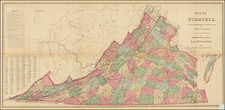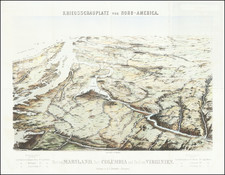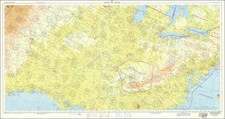This 1867 map, created by John Weyss and Nathaniel Michler, illustrates the Bermuda Hundred Campaign during the American Civil War. The map covers the region from the Dunnson farm to Jordan's Point Lighthouse on the James River and from Chaffin's Bluff and Drury's (Drewry's) Bluff to the J. Mason farm.
The Bermuda Hundred Campaign, fought in May 1864, consisted of a series of battles between the Union Army of the James, led by Major General Benjamin Butler, and a smaller Confederate force commanded by General P.G.T. Beauregard. The Union forces landed at Bermuda Hundred, a fishing village located on a peninsula at the confluence of the Appomattox and James Rivers, between Richmond and Petersburg, Virginia. Their goal was to sever the Richmond and Petersburg Railroad, a crucial rail link to the south. Several battles took place at locations labeled on the map, including the Battle of Port Walthall Junction, the Battle of Chester Station, the Battle of Proctor's Creek (also known as the Battle of Drewry's Bluff), and the Battle of Ware Bottom Church.
Despite commanding a superior force, Butler's best achievement was a stalemate. A "political general" appointed due to his loyalty to Lincoln, Butler was not a highly skilled commander. Consequently, the Army of the James was unable to occupy a large number of Confederate forces, who were reassigned to fight General Grant's Army of the Potomac at Cold Harbor and other locations.
The map depicts Confederate forces in red and Federal (Union) forces in blue, illustrating the many actions of the Bermuda Hundred Campaign, although the progression of the campaign is not indicated. Various forts, batteries, and other essential fighting locations are illustrated and labeled, as well as numerous farms and homesteads. Roads and railroads, including the Richmond and Petersburg Railroad, the Richmond and Petersburg Turnpike, and the Petersburg and City Point Railroad, are also identified.
The map was surveyed and drawn by Major John E. Weyss under Nathaniel Michler's command, engraved by Julius Bien, and published by the War Department in "Military Maps illustrating the Operations of the Armies of the Potomac and James" in 1869.









![[ Virginia Natives ] Fictilium Vasorum In Quibus Cibum Coquunt Forma XV [Their Seething of Their Meat in Earthen Pots]](https://storage.googleapis.com/raremaps/img/small/98700.jpg)


![[ Indian Territory / North Texas / Arkansas ] General Topographical Map. Sheet XXIV. Plate CLIX](https://storage.googleapis.com/raremaps/img/small/95113.jpg)
![[ Florida Native Americans -- Idol Worship ] Idolum Kiwasa XXI](https://storage.googleapis.com/raremaps/img/small/98017.jpg)
